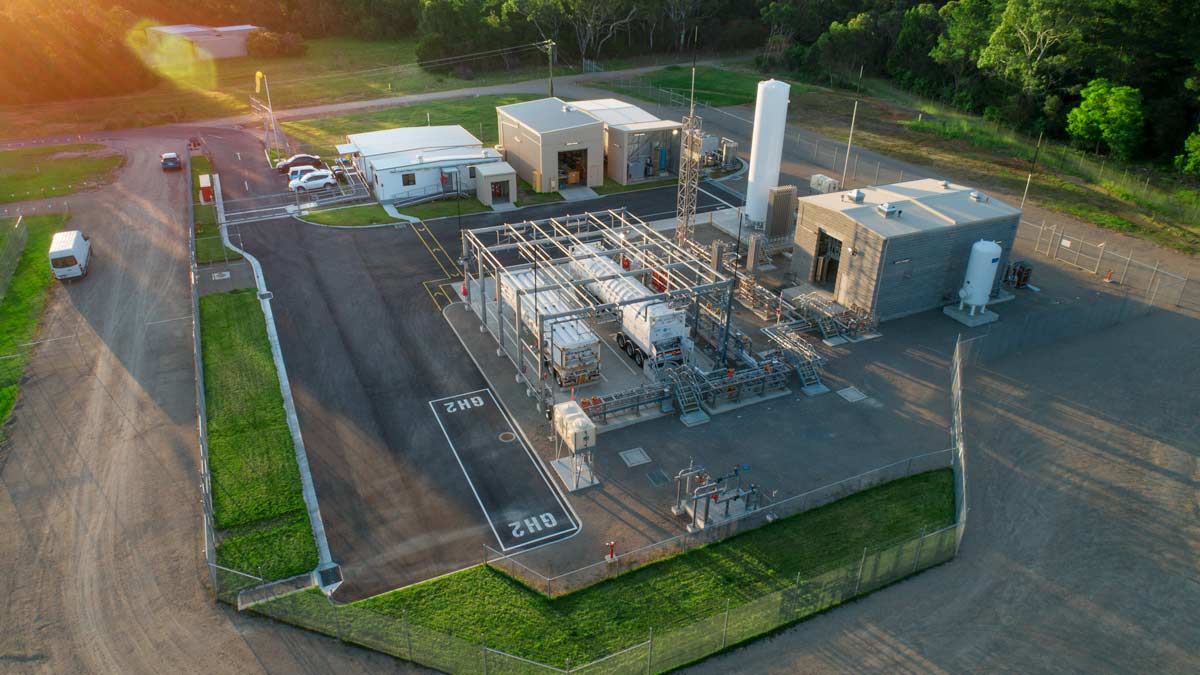Australia’s emerging hydrogen export industry has achieved a major milestone with the purpose-built Suiso Frontier arriving in Australia to take its first shipment of liquid hydrogen to Japan, even if it is with the wrong “colour” of hydrogen.
The Suiso Frontier is a dedicated liquid hydrogen transport ship built by Kawasaki and has arrived in Victoria to receive its first shipment of liquid “blue” hydrogen for delivery to customers in Japan.
“Suiso” is the Japanese term for hydrogen, and the ship is one of the world’s first dedicated liquid hydrogen carriers.
The 116-metre ship features a 1,250 cubic metre storage tank for transporting liquid hydrogen. The vessel will transport its first batch of hydrogen between the Port of Hastings in Victoria to Kobe in Japan, in a journey that will take two weeks to complete.
The ship’s arrival marks a major milestone for the Hydrogen Energy Supply Chain (HESC) project and Australia’s emerging status as a hydrogen exporter.
“The loading of liquefied hydrogen onto the Suiso Frontier for the return journey to Kobe, Japan, makes the HESC Project the most advanced and scalable hydrogen project in Australia and the first project in the world to make, liquefy and transport liquid hydrogen by sea to an international market,” the HESC project said in a statement.
But far from delivering renewable hydrogen to Japan, the project will deliver a supply of hydrogen that has been produced using brown coal with plans to combined the project with a carbon capture and storage facility.
The hydrogen used for the project has been produced through a coal gasification process, using supplies of brown coal from Victoria’s Latrobe Valley, meaning the hydrogen being sent to Japan is “brown” hydrogen, effectively made “blue” – slightly closer to green – through the use of carbon offsets during the pilot phase.

With the looming closure of Victoria’s emissions-intensive brown coal fired power stations, some – including the federal government – believe the growing demand for hydrogen could serve as an alternative use for Victoria’s brown coal deposits.
The HESC project has received significant financial backing from both state and federal governments, along with coal industry backing, as a potential demonstration of how Victoria’s brown coal could be used to produce hydrogen.
The first stage of the $496 million project – which has received $50 million in funding support from then Turnbull government and a matching amount from the Victorian government – was expected to produce just three tonnes of hydrogen over the project’s pilot stage.
The pilot project represented an extraordinary expenditure for the small volume of hydrogen actually produced and exported, leaving many to wonder why renewable hydrogen was not used.
The project has included the construction of a liquefaction facility, which cools hydrogen supplies to -253°C, condensing hydrogen gas into a liquid form, increasing its density around 800-fold.
The project says that a “commercial” phase of the project will see output grow to around 225,000 tonnes of liquified hydrogen, with associated greenhouse gas emissions stored by the CarbonNet Project, using an offshore reservoir.
On Friday, the federal government announced that it would provide $7.5 million in additional funding to support the $184 million pre-commercialisation phase of the HESC project.
The Morrison government will also pour a further $20 million into the expansion of the CarbonNet carbon capture and storage project.
“Last year, our countries affirmed our mutual ambitions and desire to work together to advance the development of low emissions technologies when we agreed the Japan-Australia Partnership on Decarbonisation through Technology,” federal energy minister Angus Taylor said.
“This project demonstrates the benefits of that cooperation. The HESC project puts Australia at the forefront of the global energy transition to lower emissions through clean hydrogen, which is a fuel of the future.”
But the true “fuel of the future” will be green hydrogen – made from renewable energy resources – and not what Taylor so freely calls “clean hydrogen.”
“We can create green energy in many different places in Australia, including the La Trobe Valley, but we can also use sequestration to produce ‘blue hydrogen’… We’re not going to get ideological about it – we want clean hydrogen.”
– @AngusTaylorMP, Energy Minister
— RN Breakfast (@RNBreakfast) January 20, 2022
For from just ideological, the different colours allocated to different types of hydrogen made from different sources of energy will be all important in future carbon constrained global trade.
A recent peer-reviewed paper from Cornell’s Robert Howarth and Stanford’s Mark Jacobson examined the ‘lifecycle’ greenhouse gas emissions from blue hydrogen and found there was “no way” it could be classed as “green.”
Conversely, the study found that hydrogen produced from gas – even with carbon capture – was significantly worse for the climate than burning coal or gas directly, due to the significant extra energy required for processes to produce hydrogen and power carbon capture and storage.
Still, the HESC project’s supporters argue that it will generate positive insights for establishing export supply chains for Australia’s broader hydrogen industry, including renewable hydrogen.
And Taylor is all for it – having campaigned hard for the Australian Renewable Energy Agency to fund blue hydrogen projects as a “next generation low emissions technology.”
The renewables industry might disagree, however – as did former ARENA chair Greg Bourne, who described the push to fund blue hydrogen as a “retrograde step” designed to “prop up fossil fuels using taxpayer money”.










